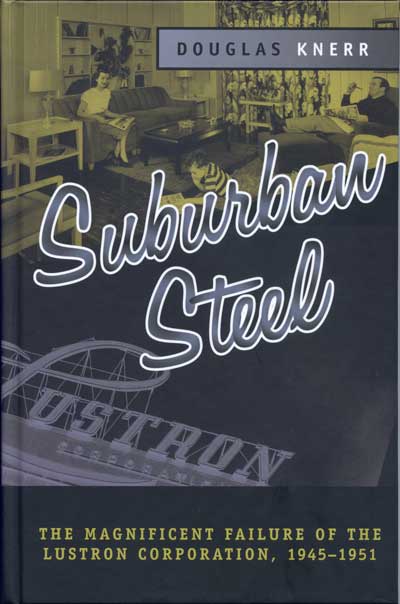|
A Choice Outstanding Academic Title for 2003 Suburban SteelThe Magnificent Failure of the Lustron Corporation, 1945–1951Douglas KnerrUrban Life and Urban Landscape |
 4/23/2004 248 pp. 6x9  $24.95 paper 978-0-8142-5273-4 Add paper to shopping cart $24.95 PDF eBook 978-0-8142-7528-3 Add PDF eBook to shopping cart Shopping Cart Instructions Review/Change Shopping Cart & Check-out | |||
|
“Suburban Steel is a remarkable book that succeeds on several levels. . . . In addition to being highly entertaining, the book is a model of scholarship . . . . A welcome contribution to courses in planning and architecture, urban studies, economics, and business.” —Choice “Suburban Steel succeeds in laying a foundation for future investigations of the contributions of the private sector’s architects, planners, and policymakers to housing policy reforms.” —Business History Review “This is a fine story well-told. Using company and government records together with contemporary commentary, Knerr weaves a lucid and intriguing narrative.” —Technology and Culture “This work establishes a sustained historical, political, and technical relationship between immediate consumer need, mass production, and an all-steel, porcelain-enameled, single family ‘product.’ . . . [T]he author also accomplishes the difficult task of interlacing technological advancements with large-scale politics. . . . [T]he material presented is rich and comprehensive.” —Journal of the Society of Architectural Historians “Knerr’s book is well written, informative, and readable. The photos and floor plans are valuable . . . . The book would be useful in courses on architecture and social history and as expanded reading in American history survey courses.” —The Journal of American History “This is a compelling and well-told story. Beyond the lively and astute recounting of the Lustron history, Knerr deftly explains complicated engineering and financial processes while placing them firmly in the larger context of postwar American business, social, and governmental history. The book is an important case study—one that would be appropriate for a twentieth-century American history or American Studies course.” —Carolyn Loeb, Central Michigan University Suburban Steel chronicles the rise and fall of the Lustron Corporation, once the largest and most completely industrialized housing company in U.S. history. Beginning in 1947, Lustron manufactured porcelain-enameled steel houses in a one-million-square-foot plant in Columbus, Ohio. With forty million dollars in federal funds and support from the highest levels of the Truman administration, the company planned to produce one hundred houses per day, each neatly arranged on specially designed tractor-trailers for delivery throughout the country. Lustron’s unprecedented size and scope of operations attracted intense scrutiny. The efficiencies of uninterrupted production, integrated manufacturing, and economies of scale promised to lead the American housing industry away from its decentralized, undercapitalized, and inefficient past toward a level of rationalization and organization found in other sectors of the industrial economy. The company’s failure marked a watershed in the history of the American housing industry. Although people did not quit talking about industrialized housing, enthusiasm for its role in the transformation of the housing industry at large markedly waned. Suburban Steel considers Lustron’s magnificent failure in the context of historical approaches to the nation’s perpetual shortage of affordable housing, arguing that had Lustron’s path not been interrupted, affordable and desirable housing for America’s masses would be far more prevalent today. 
Douglas Knerr is provost and vice chancellor of academic affairs at the University of Michigan-Flint and author of Eagle-Picher Industries: Strategies for Survival in the Industrial Marketplace, 1840–1980 (The Ohio State University Press, 1993) | ||||

